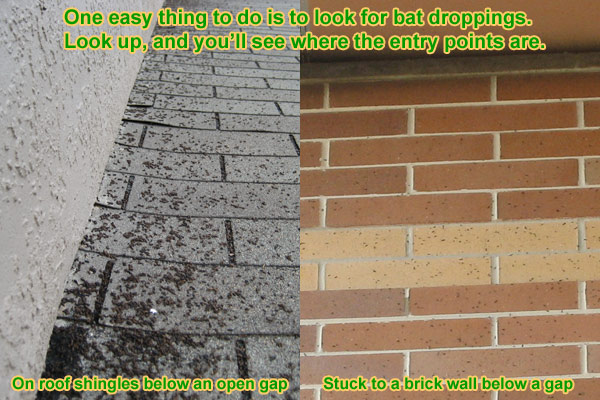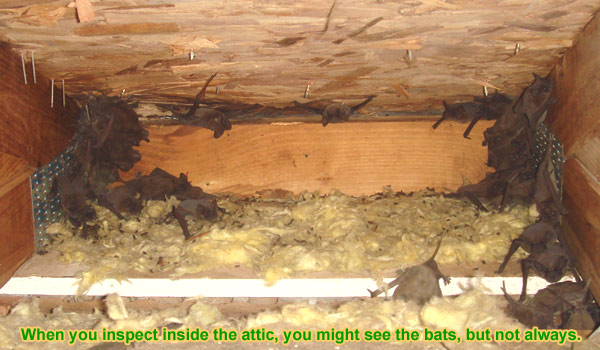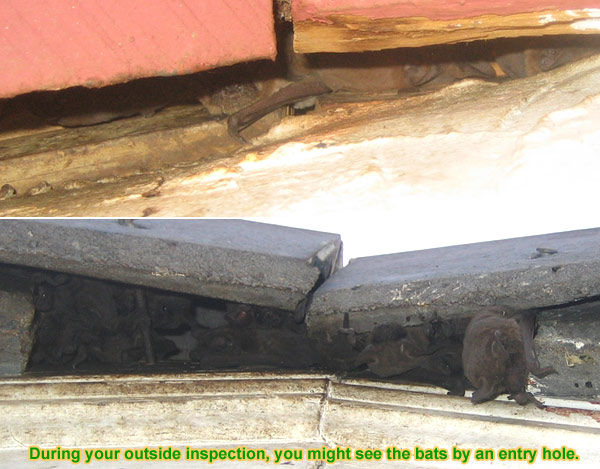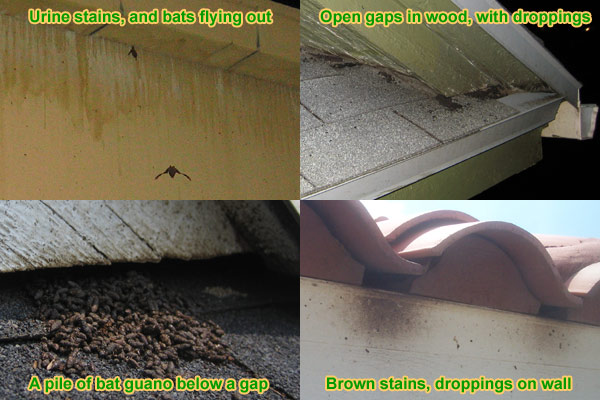- info@wildlife-removal.com
Call us for help in your town
Wildlife Removal Education
Bat Inspection - How Are Bats Getting into the Building?
Need bat removal in your hometown? We service over 500 USA locations! Click here to hire us in your town and check prices - updated for year 2020.
Click here for my nationwide list of 100's of bat removal experts serving every US town/city.
Of course, you can't properly solve your bat problem until you find out how they are getting into the building. This requires a very detailed inspection of the whole structure. You must
pour over every inch of the building, and you must have a sharp eye. Bats can enter a cap as small as 3/8 of an inch! Experience definitely helps when doing a building inspection for
bats. A knowledge of their behavior, and of the often subtle signs they leave behind, helps a great deal in identifying all the entry points. You must identify 100% of the entry points,
or the bat removal job will fail. Read Bat entry holes: What they look like and how to find them.

Access to the right tools helps. Bats often enter and exit at very high areas. They prefer it that way, so that they are safe from predators, and so that they have room to swoop out, and clearance to fly in
and out. I use many ladders, up to 40 feet. I must move the ladders around many times to get my nose up and in all the little nooks and crannies. I often climb on the roof, and swing over the edge to look
up and into all the eave gaps, fascia boards, and other areas that bats can use to enter a building.

Here's a photo of a classic bat entry - we can see all kinds of easy clues. First of all, it's high up on a house, on an open corner. It's easy to see wide-open gaps where the soffit doesn't
sit flush against the roof. Bats have a brown grease in their fur, so you usually see brown stains at the point of entry and exit. Bats also poop a lot, so it's common to see scattered bat
droppings around the entry hole, often stuck to the sides of the walls or on the shingles. But I have to tell you - it's rarely as obvious as in this photo. This particular house had an infestation
of almost a thousand bats, and they'd been living there for many years. So this entry was as clear as could be. But most are more subtle. Bat Urine Removal And Urine Stain Removal

One of the first things you can do is look for the droppings. Read about Damage from bats in your Attic. Bats always crap all over the place, including in the air as they fly about and circle the building. Find the droppings, and you'll
find where the bats are going in and roosting. Sometimes the bat waste will accumulate on the ground or lower shingles of a house, below the entry point, or sometimes it'll be stuck to the side
of the wall. Just look up, and you'll likely see some entry points.

It's also important to inspect inside the attic. There, you'll often notice the odor of bats. It's immistakeable. You also might see bat droppings, and you might even see bats themselves, flying around
or crawling in a corner or edge of the attic, such as in the above photograph. But not always. Animals are great at hiding themselves, and most of the time, bats wedge themselves into hidden gaps. Most
of the time, I do not actually spot bats in the attic - in fact, I'd say less than 10% of the time do I actually see bats, even if there are hundreds in there - wedged in the walls, between fascia boards, etc. If you're worried about lung infections, read Histoplasmosis From Bats: What You Need to Know.

On rare occasion, you'll actually spot bats roosting at an entry hole. But this is not common.

Here we see photos from four different places. In the upper-left, it's a big group of bats going into an industrial warehouse. They left all sorts of urine streaks down the side of the wall. You can see
that I took this photo at night, and caught a couple of bats coming out of the gap. In the upper-right and lower-left, we see some gaps in homes, and evidence of brown staining, and lots of bat droppings. In
the lower-right, we see gaps below a spanish-style barrel tile roof, and there are brown stains below the entry holes, and bat droppings scattered on the edge of the wall. How To Remove Bat Feces From Concrete
But I've left out one of the most important parts of the bat inspection: get outside at dusk, and watch the bats come out! You'll be surprised at how many you see exiting, and from some of the areas you
see them exiting, holes and gaps you didn't even know existed! The night watch is crucial, in my opinion, toward getting a full understanding of the bat situation, and properly addressing it. Here's
and article I wrote for a magazine about doing bat exclusion work at night.
Should you look for evidence of chewed wires? Read about Do bats chew on wires? Furthermore, Can bats chew though spray foam, wood, or screen?
I have written several other detailed articles:
How to get bats out of the attic
Remove bats flying inside the house
How to get bats out of the chimney
Bat trapping
How to catch a bat
Bat prevention methods
Bats in a Barn – What's the Best Way to Get Rid?
The author, David, is a bat removal expert with
over 500 successful bat control jobs under his
belt. I want to stress the importance of proper
bat removal, and the value of these animals to
the ecosystem. I've witnessed dozens of failed
do-it-yourself bat jobs over the years, and it
is not pretty - dead bats, horrible odors,
rabies vaccinations, and so on. Read What happens after wildlife control exterminators get rid of bats? Bat removal work
is not easy - I trained for two years learning,
and even then, it took many jobs and hands-on
training before I was competent. I highly
recommend that you consult my list of wildlife
control companies on the home page, and hire a
professional to come out and look at your bat
problem. Get a few quotes if you must. Read more about Choosing the right company to get rid of bats. And
remember, do not perform any bat exclusions during the summer maternity months. For more general information and links, go to my main bat removal page.


















